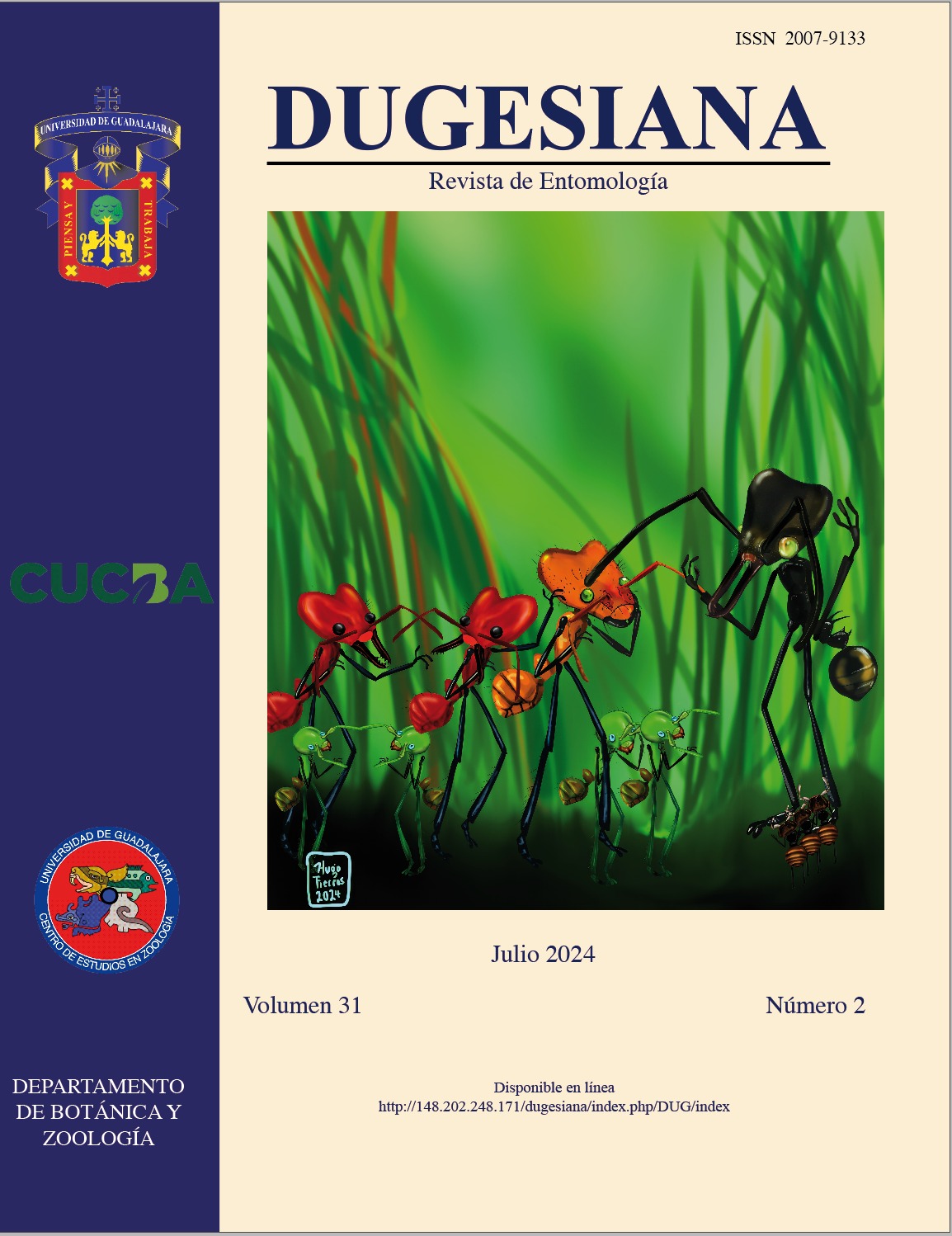Hidden in the cracks, a new species of Scorpion from Michoacan, Mexico (Scorpiones: Vaejovidae)
DOI:
https://doi.org/10.32870/dugesiana.v31i2.7340Keywords:
diversity, endemism, sympatry, lithophilousAbstract
A new species of Vaejovis is described for Michoacan, Mexico belonging to the nigrescens/nitidulus group, the less diverse group of species from the genus. This species has a preference for synanthropic environments and inhabits rock walls within the city limits. Additionally, the pictures of the hemispermatophore are presented and characters are named according to new terminology. This species is named honoring Dr. Gabriela Castaño Meneses for her great contributionsto arthropods research in Mexico and the world.References
Chávez-Samayoa, F., J.E. Díaz-Plascencia and E. González-Santillán. 2022. Two new species of Vaejovis (Scorpiones: Vaejovidae) belonging to the mexicanus group from Aguascalientes, Mexico, with comments on the homology and function of the hemispermatophore. Zoologischer Anzeiger 298: 148–169. https://doi.org/10.1016/j.jcz.2022.04.005
Contreras-Félix, G.A. and O.F. Francke. 2019. Taxonomic revision of the “mexicanus” group of the genus Vaejovis C.L. Koch, 1836 (Scorpiones: Vaejovidae). Zootaxa,4596(1): 1–100. https://doi.org/10.7550/rmb.37437
Contreras-Félix, G.A., O.F. Francke and R.W. Bryson Jr. 2015. A new species of the “mexicanus” group of the genus Vaejovis C.L. Koch, 1836 from the Mexican stateof Aguascalientes (Scorpiones: Vaejovidae). Zootaxa, 3936(1): 131–140. https://doi.org/10.3958/059.046.0119
González-Santillán, E. and L. Prendini. 2013. Redefinition and generic revision of the North American Vaejovid Scorpion subfamily Syntropinae Kraepelin, 1905, with description of six new genera. Bulletin of the American Museum of Natural History, 380: 1–71. https://doi.org/10.1206/830.1
Loria, S.F. and L. Prendini. 2014. Homology of the lateral eyes of Scorpiones: A six-ocellus model. PloS One, 9(12): e112913. https://doi.org/10.1371/journal.pone.0112913
Prendini, L. 2003. Revision of the genus Liposoma Lawrence, 1928 (Scorpiones: Bothriuridae). Insect Systematics and Evolution, 34(3): 241–264. https://doi.org/10.1163/187631203788964764
Santibáñez-López, C.E. y D.W. Sissom, 2010. A new species of the Vaejovis eusthenura group in Oaxaca, Mexico (Scorpiones: Vaejovidae). Zootaxa, 2493(1): 49–58. 10.11646/ZOOTAXA.2493.1.4
Santibáñez-López, C.E., E. González-Santillán, L. Monod and P. Sharma. 2019. Phylogenomics facilitates stable Scorpion systematics: Reassessing the relationships of Vaejovidae and a new higher-level classification of Scorpiones (Arachnida). Molecular Phylogenetics and Evolution, 135: 22–30. https://doi.org/10.1016/j.ympev.2019.02.021
Sissom, W.D. 1991. Systematic studies on the Nitidulus group of the genus Vaejovis, with description of seven new species (Scorpiones, Vaejovida). The Journal of Arachnology, 19(1):4–28.
Sissom, W.D. and O.F. Francke. 1985. Redescription of some poorly known species of the Nitidulus group of the genus Vaejovis (Scorpiones, Vaejovidae). Journal of Arachnology, 13(2): 243–266.
Soleglad M.E. and V. Fet. 2005. A new scorpion genus (Scorpiones: Vaejovidae) from Mexico. Euscorpius, 24:1–13. https://dx.doi.org/10.18590/euscorpius.2005.vol2005.iss24.1
Stahnke, H.L. 1970. Scorpion nomenclature and mensuration. Entomological News, 81(12): 297–316.
Vachon, M. 1952. Étude sur les Scorpions. Institut Pasteur d’Algérie. Algeria.
Volschenk, E.S. 2005. A new technique for examining surface morphosculpture of Scorpions. Journal of Arachnology, 33(3): 820–825. https://doi.org/10.1636/s03-047.1
Zárate-Gálevez, K. and O. F. Francke. 2009. A new Vaejovis (Scorpiones: Vaejovidae) from Chiapas, México. Zootaxa, 2313(1):61–68. 10.11646/ZOOTAXA.2313.1.3
Published
Issue
Section
License
1. Proposed policy for open access journals
Those authors who have publications with this journal, accept the following terms:
- The authors will retain their copyright and will guarantee to the journal the right of first publication of their work, which will be simultaneously subject to the Creative Commons Recognition License, which allows third parties to share the work whenever their author is indicated and His first publication is this journal.
- Authors may adopt other non-exclusive license agreements to distribute the version of the published work (eg to be deposited in an institutional telematic file or published in a monographic volume) provided the initial publication is indicated in this journal .
Authors are encouraged and encouraged to disseminate their work through the Internet (eg in institutional telematic files or on their web page) before and during the sending process, which can produce interesting exchanges and increase appointments Of the published work. (See The effect of open access).
2. Proposed policy for journals that offer open deferred access
Those authors who have publications with this journal, accept the following terms:
- The authors will retain their copyrights and will guarantee to the journal the right of first publication of their work [SPECIFY PERIOD OF TIME], which will be simultaneously subject to the Creative Commons Recognition License that allows third parties to share the work always That its author and his first publication be indicated this journal.
- Authors may adopt other non-exclusive license agreements to distribute the version of the published work (eg to be deposited in an institutional telematic file or published in a monographic volume) provided the initial publication is indicated in this journal .
- Authors are encouraged and encouraged to disseminate their work through the Internet (eg in institutional telematic files or on their web page) before and during the sending process, which can produce interesting exchanges and increase appointments Of the published work. (See The effect of open access).




